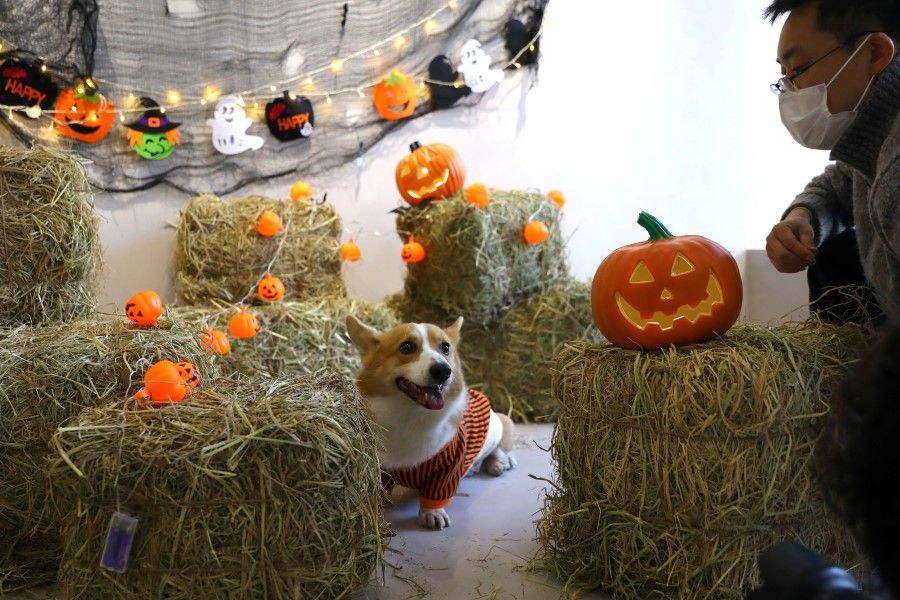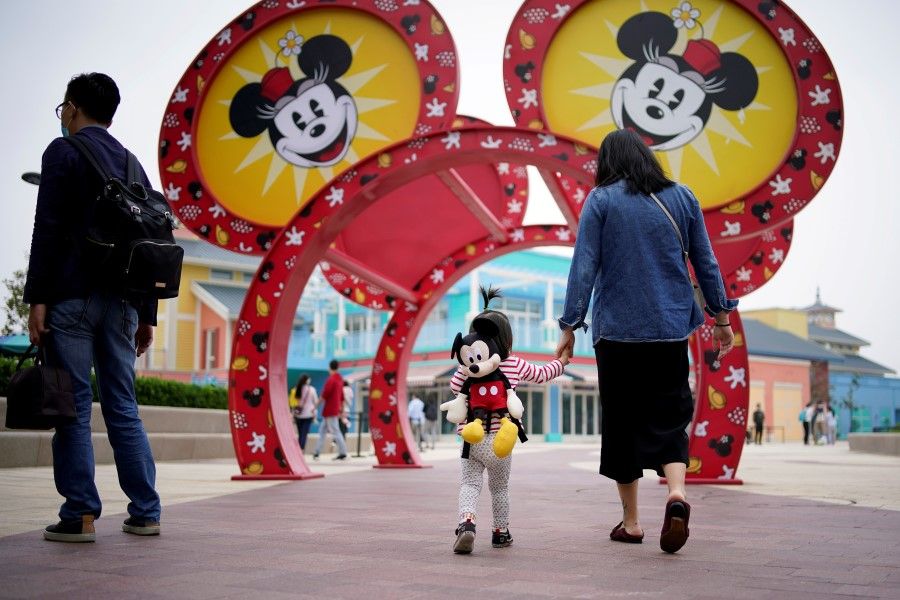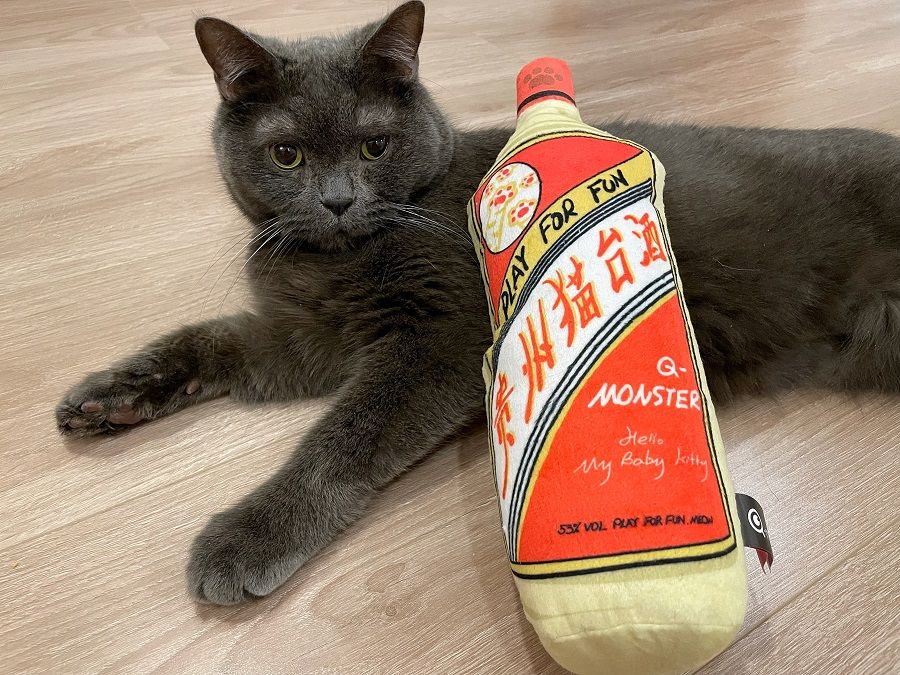China's pet industry booms as the post-90s generation seeks to fill a void

(All photos courtesy of interviewees unless otherwise stated.)
Hotel marketing personnel Zhao Yi, 24, lives with his parents, but they have little in common to talk about. Zhao is closest to a poodle called Ben Ben - every day when Zhao gets home, he plays and talks with Ben Ben; sometimes they would even end up having a "tiff" and give the other the cold shoulder.
During the Singles' Day period in 2019, for the first time, cat food overtook milk powder as the top-selling product on Tmall, with 14,000 tonnes sold.
Products for pets continued to thrive during this year's Singles' Day period too, with searches for "pet products" among the younger group up by 14.2% as compared to last year. Just ten minutes into Singles' Day sales, transactions of food, deworming products, and nutritional products for pets on JD.com were up 22 times, six times, and 12 times year-on-year.
From these amazing sales figures, market analysts and investors are witnessing the power of the pet economy in China.

This year's white paper on consumer trends for pets in China by iResearch Consulting Group shows that from 2019 to 2021, China's pet market grew by a steady 16% to 18%, and is expected to hit 348.8 billion RMB (S$47.35 billion) in 2021. In the next three years, China's pet industry will show a compound growth rate of 14.2%, or about 50 billion RMB a year, reaching 445.6 billion RMB by 2023.
US investment company Goldman Sachs is even more optimistic about China's pet economy. A report by the company released in September forecast that China's pet food industry will show a compound annual growth of nearly 20% in the next ten years. And although the forecast figures are different, the signal from these market analysts to investors is clear: China's pet market is an emerging industry that is worth watching.
China's pet industry is second only to the US. In China, one out of five households, or 22% of people have pets. This is one-third of the figure in the US, but the growth rate of spending on pets is far higher than in the US. Over the past ten years, the pet food market has seen annual growth of over 25%, at least five times the rate in the US, showing the high growth potential of China's pet industry.
...in China, nearly 40% of pet owners are male.
Pets provide one-child generation with emotional connections
Post-90s consumers like Zhao are the main drivers of China's pet economy. The iResearch report shows that 47% of pet owners in China are those born in the 90s, while 41% are those born in the 80s - this group grew up under the one-child policy.
Most people have the impression that pet owners are mostly female, but in China, nearly 40% of pet owners are male. Among Zhao's peers, "almost everyone has a pet", regardless of gender. Also, the role of pets is no longer to guard the home, but as friends, partners, and even children to be loved.
Last year, Zhao heard that his friend's poodle had puppies; within a day, he decided to bring home a dog he had never met, and named it Ben Ben.
Zhao is an only child living with his parents. As he grew older, he felt a growing distance from his parents. They communicated less, and he felt a growing desire to keep a pet.

Every day after work, Zhao takes Ben Ben for a half-hour walk and talks to it, before they each "do their own thing", and then go to bed together.
Zhao shared with Zaobao: "Sometimes Ben Ben makes me angry and I ignore it. Then it quietly goes to sleep on its own, and the next day it comes to make up, just like a human." For Zhao, such simple companionship makes for the most heartwarming moments in owning a pet.
Tan Gangqiang, head of a psychology consultation centre in Chongqing (重庆市协和心理顾问事务所), said the rise of the pet economy has to do with the maturing and spread of the one-child generation, while the emptiness of being stuck at home during the pandemic has also prompted young people to seek the companionship of pets.
Tan explained that the one-child generation was raised by "electronic babysitters" and are used to living in the virtual world. While it seems that young people have more friends, they are actually feeling lonelier because they do not have siblings around their age, and have generational conflicts with their parents. Many people also move to big cities where they drift around and lack inner stability and real social connections. Under such circumstances, pets become their "rescue" and provide the emotional connection they need.
Income and standard of living driving growth of pet economy
The overall increase in China's income and standard of living is the most direct factor in driving the growth of the pet economy. Over 60% of pet owners in China have a monthly income of between 8,000 and 25,000 RMB, and over 80% have at least undergraduate qualifications. In 2020, per capita annual spending per pet in China was 6,653 RMB, a 19.6% increase year-on-year.
For some middle-income households, the cost of owning a cat is equivalent to a family trip to Disneyland.
...while the Chinese mainly have pets to make themselves happier, de-stress and cope with loneliness, 10% and 11% of pet owners do so to strengthen their sense of identity and increase their social interactions respectively.

Xiaorong (pseudonym), 45 and her 14-year-old daughter adopted a stray cat with feline infectious peritonitis, which cost over 1,000 RMB to treat. "I let my daughter decide whether to save the cat or go on a family trip to Disneyland. She chose to save the cat."
This local breed named Miao Miao is the second cat in Xiaorong's household. Her "pet family" also includes four chinchillas and two hamsters. Xiaorong spends less than 1,000 RMB each month on these pets. Occasionally there are medical costs of a few thousand RMB, but in general, it is not too much of a financial burden, even for a household with a child.
China's pet culture is slowly taking root in the middle class. Based on the aforementioned white paper on China's pet industry in 2021, while the Chinese mainly have pets to make themselves happier, de-stress and cope with loneliness, 10% and 11% of pet owners do so to strengthen their sense of identity and increase their social interactions respectively.
As China's middle class has a stronger purchasing power, gone are the days where pets are fed leftovers. Aside from the fact that a bag of imported cat food costs over 800 RMB and pet grooming services cost between 200 RMB and 400 RMB, unique pet services have sprung up, such as pet detectives who help to find missing pets, pet matchmakers who will find the perfect mate for pets, pet boarding hotels, a pet paradise designed specially for pets, animal communicators, pet insurance, pet travel, pet photography and pet telemedicine.

Tan from the psychology consultation centre pointed out that the variety of services reflect that new-generation pet owners have personified their pets and truly see the latter as their companions. These doting owners feel they can express their personal aesthetic through their pets, and are willing to foot the bill for them.
Animal communication a new booming industry
"Why is my cat unwilling to sleep on the bed with me?", "Why is my dog unwilling to eat?", "Did my rabbit run away from home?" - these are just some of the frequently asked animal communicator Bei Li has dealt with in her three years in the industry. Her job is not only about reading a pet's mind, but also solving the issues that weigh heavily on the pet parent's mind.
The field of animal communication emerged in European and American countries in the 1990s. Animal communicators normally operate as individual entities overseas, and are even labelled by some as having dealings with spirits and demons. But 35-year-old Bei is not some unknown pet spirit medium - she is the CEO of a patented animal communication enterprise with ten employees and five service outlets in China.
Animal communicators seek to understand a pet's feelings and physical well-being. They even try to sense the whereabouts of a missing pet through the pet's photograph. This industry began to emerge in China in 2019. This was when Bei seized the business opportunity and quit her job in advertising to set up "Asian Animal Communication Alliance (AACA)" with a business partner.

The two main business portfolios of AACA are animal communication consultation services targeted at pet owners, and professional animal communication training courses targeted at the general public. Consultation services cost between 268 RMB and 400 RMB, while a full training course costs approximately 15,800 RMB.
Industry workers: revenue expected to triple in next two years
While the animal communication industry emerged relatively later in China, the huge pet market implies that with sound business plans, this unique industry could also ride on the economic boom of the pet economy and rapidly grow to become an industry of significant scale.
Bei stated that the company's revenue has increased at a rate of nearly 100% in the past year. During the period of the Covid-19 pandemic, the demand for animal communication services greatly increased, and the company's ten animal communicators were fully booked every month. The enterprise plans to increase the number of service outlets in the country, and expects its revenue over the next two years to grow by 100% to 300%.
Bei thinks that the development of the animal communication industry reflects the transformation of the overall pet industry. As people enjoy a better standard of living, pet parents also want their furkid to have a better quality of life. Their pet's physical health is no longer their only concern; they care very much about their pet's mental health too.
People of the younger generation are more concerned about their pet's mental health, such as whether or not the latter is happy, or if it is satisfied with its living environment. On the other hand, older folks are more concerned about their pet's physical health, such as the type of massage it would enjoy or other health services it might need.
Animal communicator job as backup plan amid the pandemic
Bei's customers are mainly the younger post-90s generation. She also serves a smaller group of retirees, the older post-50s generation, who have completely different needs from the post-90s generation.

People of the younger generation are more concerned about their pet's mental health, such as whether or not the latter is happy, or if it is satisfied with its living environment. On the other hand, older folks are more concerned about their pet's physical health, such as the type of massage it would enjoy or other health services it might need. The stark difference between both parties reflects people's state of mind at different ages - in the process of taking care of their pet's mental health, the pet parent's own psychological needs are also fulfilled.
In terms of animal communication training, Bei noticed that they had seen their highest number of signups - nearly 100 - at the height of the pandemic last year. With the pandemic bringing much uncertainty to young people's employment prospects, the animal communication industry, with low barriers to entry, became a popular backup part-time job for many people.
Bei pointed out that as many pet shops suspended operations in the early stages of the pandemic, industry workers took the chance to learn a new skill. Not only that, since the start of the year, people from outside the industry have also signed up. Most of these trainees are white-collar professionals who are pet owners, hoping to understand their own pets and possibly provide animal communication services to others to earn extra money in the future.
The homogeneity of products is an issue
Market analysts predict that local Chinese pet brands will enjoy rapid growth in step with the burgeoning pet economy. However, with the increasingly glaring issue of the homogeneity of brands, only the fittest will survive, while the rest will be eliminated at a faster rate. This also implies that local Chinese pet brands have entered the stage of intense competition.

China's rising pet economy has brought about a wave of national pet brands. There are currently more than 2,500 Chinese pet brands on JD.com. According to statistics from iiMedia Research, among the top ten pet brands during the Singles' Day sale in 2020, 60% are Chinese brands.
Local Chinese pet brands are also showing their muscle in bringing in revenue. In the first six months of 2021 alone, there were 25 financing activities in China's pet industry, most of which involved pet food and pet supplies companies. The total amount of funding achieved reached 6.056 billion RMB, double the amount recorded in the same period last year.
While the onslaught of Chinese pet brands has brought about massive investment opportunities, investors are at the same time concerned about the sustainability of the brands.
iiMedia Research chief analyst Zhang Yi told Zaobao that competition among homogeneous brands is set to become the biggest challenge for China's pet industry. For example, industry workers will have to think about how their brand of pet food will be able to outcompete other brands also selling pet food. Zhang pointed out that amid the rapid development of the pet economy, only the fittest will survive - as the market expands, the market elimination rate is also expected to increase at the same time.
Related: Rejecting their parents' lifestyles, more single Chinese youths are sharing their everyday lives through vlogs | Chinese single women ponder love, marriage and freedom | China's livestreaming e-commerce: The million dollar business fueling product innovation | Beware the e-commerce bright spot in Chinese economy
